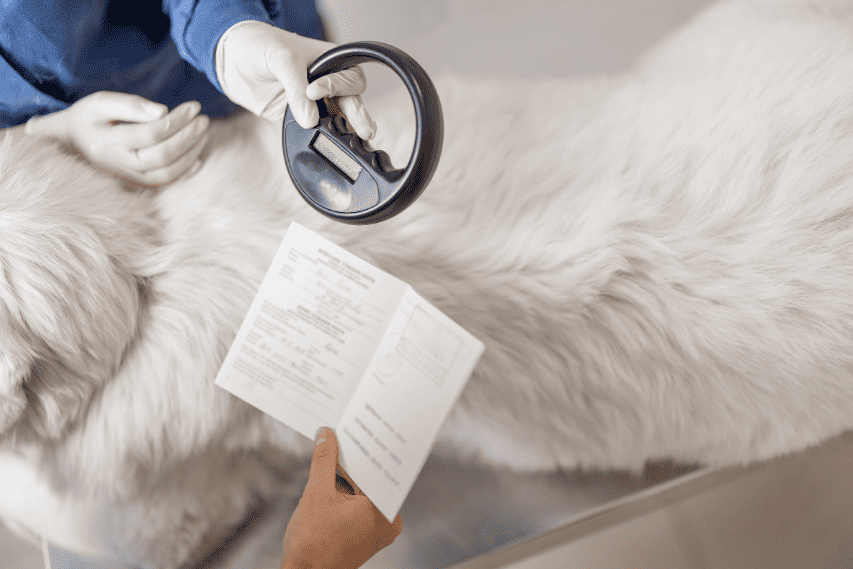Humans and their pets share an unbreakable bond. Taking care of these precious beings should be our top priority as their guardians. Among the myriad of safety precautions available to pet owners, microchipping has emerged as a revolutionary tool. But a crucial question lingers: “At what age should I microchip my dog?” “
Table of Contents
This article unravels the intricacies of microchipping, focusing on the ideal age and the compelling reasons behind it. Dive in to make an informed decision that could play a pivotal role in your canine companion’s safety.
Is It Really Important To Microchip My Dog?
One of the significant strides in pet safety and identification is the introduction of pet microchips. These tiny devices, roughly the size of a grain of rice, are implanted beneath the skin of pets and serve as a permanent ID system.
If a pet ever gets lost, a quick scan of this chip can provide all the information needed to reunite the furry friend with its family.

At What Age Should I Microchip My Dog?
When it comes to the right age for microchipping dogs, experts generally agree that earlier can often be better. The most common age bracket is between 7 to 8 weeks of age. This coincides with the first round of vaccinations that puppies typically receive, making it a convenient period for both the vet and the pet owner.
Why Should I Microchip My Dog At A Young Age?
– Minimised Risk:
Puppies, known for their resilience, tend to recover rapidly from procedures. When microchipped at a younger age, the brief discomfort they might feel is swiftly overshadowed by their innate healing abilities. This quick and non-invasive procedure is akin to receiving a routine shot, ensuring minimal stress to the young canine.
– Early Identification:
The unpredictability of puppies can sometimes lead to unexpected wanderings. In the unfortunate event that a puppy goes missing, a microchip acts as an immediate ID, significantly boosting the chances of a quick reunion. This tiny device becomes the voice for a lost puppy, echoing its identity to those who find it.
– Avoiding Procrastination:
Setting a microchipping schedule in line with veterinary recommendations creates a proactive approach to pet safety. By doing so, pet owners steer clear of potential delays, ensuring that the critical task of microchipping doesn’t fall by the wayside or get buried under other responsibilities.
Is It Ever Too Late To Microchip My Dog?
The beauty of microchipping lies in its versatility. While the recommendation is to chip dogs while they are still puppies, older dogs can and should still be microchipped if they haven’t been already. The procedure remains relatively the same regardless of age and ensures that dogs, young or old, can always find their way home.
The Procedure: Simplicity and Efficiency
For those unfamiliar with the microchipping process, it’s a straightforward procedure. A qualified veterinarian uses a syringe to implant the microchip beneath the skin, usually between the shoulder blades. The process takes mere seconds, and while some dogs might feel a slight pinch, most remain unfazed. It’s non-invasive, safe, and, most importantly, a one-time procedure.
Aftercare and Database Maintenance
Once the microchip is implanted, the responsibility shifts to the pet owner. It’s vital to:
– Register the Microchip:
Once the microchip is implanted, the next pivotal step is its registration. Ensuring the chip is registered to a reliable database and that it contains current contact information is paramount. This solidifies the link between a pet and its owner, making swift reunions possible.
– Regular Checks:
Like any technology, occasional checks are essential to verify its functionality. During periodic vet visits, it’s wise to request a quick scan of the microchip. This ensures it’s still operational and serves as a constant reminder of the pet’s safeguarded status.
– Update Information:
Life is ever-changing, and as such, personal details might shift. Whether it’s a new address or a changed phone number, prompt updates to the microchip database are crucial. This proactive measure ensures that if a pet is found, the path back home is always clear and straightforward.

Misconceptions and Myths
It’s not uncommon to encounter myths about microchipping. One such myth is that microchips act as trackers, providing real-time location data. This is not the case. Microchips are purely identification tools and do not have tracking capabilities.
Another myth revolves around the pain associated with the procedure. In reality, microchipping is no more painful than a standard vaccination and is over within seconds.
In Conclusion
Deciding the right age to microchip a dog is a crucial consideration for every responsible pet owner. While the window of 7 to 8 weeks is widely recommended, it’s never too late to ensure a pet’s safety through microchipping.
The benefits far outweigh any misconceptions, and in the quest to provide the best for one’s pet, microchipping emerges as an indispensable tool. It is a testament to an owner’s commitment to their pet’s well-being and a beacon of hope should the unexpected ever occur.



